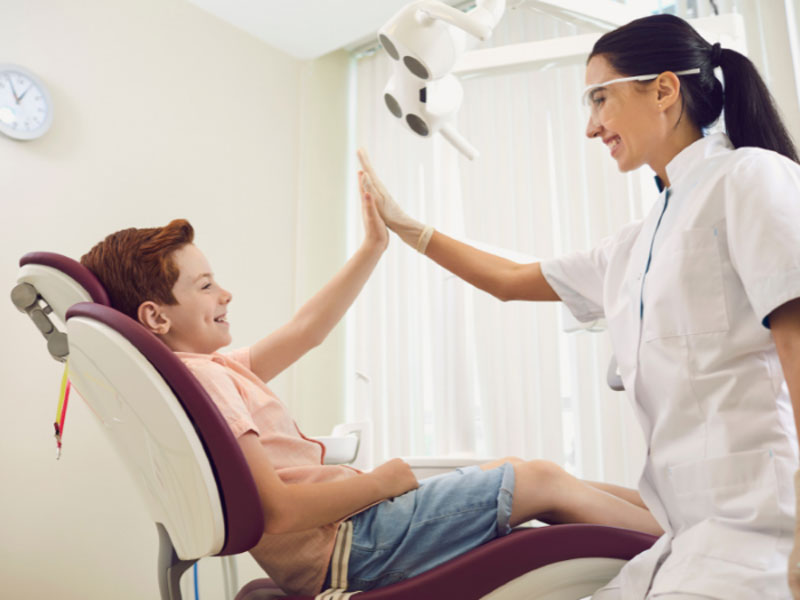Dental Tips for Kids

It is believed by many that teeth development for children starts when they are between one and four years old, but this isn’t the case. Formation of milk teeth begins when the fetus is five weeks in development, and the first baby teeth are seen on the surface of the gum when the infant is between four months and one year old.
By the time a child is born, it has a set of 20 teeth which is still inside the gum yet to grow. Incisors are the first teeth to erupt, then the canines, followed by premolars, and lastly molars.
Teething
Every child is different from the other and teething (eruption) also varies from child to child. By the time a child is turning three years old, he/she will have a set of 20 teeth, ten teeth on the lower jaw and ten teeth on the upper jaw. When a child is born, it has its mother’s antibodies until it reaches six months. The child is prone to childhood illnesses the moment it reaches six months and at this age is when the first set of teeth erupts for most kids. A lot of parents relate childhood illnesses to teething, but this isn’t always the case. Teething can last for eight days - four days are before the eruption and three days are after the teeth have grown.
Signs of Teething
- Gums appear swollen
- Gums color darkens, and a cyst which is greyish appears on the gum which will disappear on its own.
- A child becomes irritated, and it is hard to keep the child comfortable.
Teething Tips
- Teething rusks or biscuits that don’t contain sugars. When a child chews on the biscuit, it relieves the itchiness that comes with teething.
- Massaging the kid's gums with your fingers or clean cloth will help reduce itchiness.
When is the best time to start cleaning your kid’s teeth?
Oral hygiene is crucial for a child. Most mothers don’t see the necessity of cleaning an infant’s gums since they don’t have teeth. Cleaning your child’s gums as early as birth will protect their future teeth from decay. Here is a list you can refer to according to your child's age.
- 0-first teeth - Use a clean cloth to remove traces of infant food and milk.
- First tooth - one year old. Use a soft toothbrush suitable for kids and plain water to clean your child’s teeth. Brush twice daily. When your child turns one year take him/her to a dentist for the regular checkup.
- 1 1/2 years - 2 1/2 years - Put a pea-sized amount of toothpaste that’s suitable for children on a soft-bristled toothbrush. Don’t encourage swallowing of toothpaste, instead instruct your child to spit out the paste after brushing.
Flossing should begin when your child is 2 1/2 years. The child should continue with children’s toothpaste until he/she is six years of age. By the time your child is eight years old, he/she should be able to brush their teeth unsupervised.
Dental Visits
Dental visits can be hard for some kids and preparing them beforehand can help. You can talk about teeth cleaning to your child and make him/her understand the importance of visiting the dentist. For younger kids, you can play games that are dental themed. It will prepare the child for the next visit, and they will be ready to go to the dentist. If it is the first time, it can be a bit disconcerting, but you can still prepare your child by telling him/her what is going to happen during the visit so that surprise does not catch them.
Tooth Decay
The American Dental Association changed their guidelines concerning the use of fluoride toothpaste after an increased number of tooth cavities were reported. ADA recommends using fluoridated toothpaste on your kids immediately after they have their first tooth erupt. In the United States, 25% of preschool children have had cavity related illnesses, and this number goes up to 55% by the time the kids are in kindergarten. Tooth decay is a prevalent disease in children, and most health bodies such as the American Academy of Pediatric Dentistry and the Center for Disease Control and Prevention supports the practice of using fluoride toothpaste for children’s teeth.
How to Brush the Right Way
Brush your kid’s teeth in a circular motion with a toothbrush. Brush for two minutes to ensure you remove food residues on your child’s teeth. Brushing teeth in a back-and-forth motion isn’t the best way to clean your or your child’s teeth.
More Dental Tips
- Preach what you do. You should be an excellent example to your kids as children will always learn by looking at you. Brush your teeth after every meal, floss regularly and eat healthy food.
- Encourage your children to brush their teeth after every meal even when they are going to school. You can have them carry a travel-sized toothbrush while going to school and brush their teeth after their meals.
- Choose a dentist you can trust and don’t change dentists frequently. It becomes much more comfortable to visit a dentist for regular dental visits when the dentist is the same you attended the first time. Your kids will be pleased with a dentist they are used to seeing when they visit a dental clinic.
- Tell them the importance of flossing and teach them how to floss on their own.
- Reward your kids for every good dental habit they practice as this will encourage them to keep on practicing the right habits.
For more information about pediatric dental care, contact us at Fine Dentistry of Downtown Orlando. Drs. Aileen Trivedi and Troy Gessner will provide gentle, safe, and effective pediatric dental care for your child. You can count on Fine Dentistry of Downtown Orlando to meet the entire family’s dental needs. Reach out to us today!





Please login to publish a comment.
Comments (0)